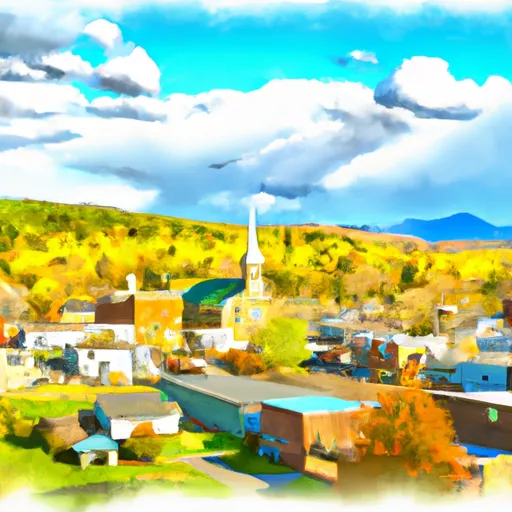-
 Snoflo Premium
Snoflo Premium
Get unlimited access to all our content
With no Ad interruptions! - Start Your Free Trial Login with existing account
Salisbury
Eden Index
Climate
8.1
•
Recreation
6.6
•
Community
1.1
•
Safeguard
5.8/10

Salisbury, Vermont is a picturesque town located in Addison County. It experiences a humid continental climate, characterized by warm summers and cold winters. Average summer temperatures range from 70°F to 80°F, while winter temperatures can drop below freezing, averaging around 20°F. The area receives moderate precipitation throughout the year, with an average annual rainfall of about 40 inches and snowfall of approximately 80 inches.
Salisbury is blessed with an abundance of hydrological features. The town is home to several rivers and streams, including the Otter Creek, which flows through the heart of the community. These waterways offer opportunities for fishing, boating, and kayaking. The area is also dotted with numerous ponds and lakes, such as Lake Dunmore and Fern Lake, providing additional options for water-based activities.
Outdoor enthusiasts will find a plethora of recreational opportunities in Salisbury. The town is surrounded by the stunning Green Mountains, offering excellent hiking and biking trails. Nature lovers can explore the nearby Moosalamoo National Recreation Area, known for its scenic beauty and wildlife. Additionally, camping, hunting, and birdwatching are popular activities in the area. Salisbury's natural beauty and diverse outdoor offerings make it an ideal destination for nature enthusiasts and adventure seekers.
What is the Eden Index?
The Snoflo Eden Index serves as a comprehensive rating system for regions, evaluating their desirability through a holistic assessment of climate health, outdoor recreation opportunities, and natural disaster risk, acknowledging the profound impact of these factors on livability and well-being.
Climate Health Indicator (CHI): 8.1
Salisbury receives approximately
1011mm of rain per year,
with humidity levels near 76%
and air temperatures averaging around
8°C.
Salisbury has a plant hardyness factor of
4, meaning
plants and agriculture in this region thrive during a short period during spring and early summer. Most
plants will die off during the colder winter months.
By considering the ideal temperature range, reliable water supplies, clean air, and stable seasonal rain or snowpacks, the Climate Health Indicator (CHI) underscores the significance of a healthy climate as the foundation for quality living.
A healthy climate is paramount for ensuring a high quality of life and livability in a region, fostering both physical well-being and environmental harmony. This can be characterized by ideal temperatures, reliable access to water supplies, clean air, and consistent seasonal rain or snowpacks.
Weather Forecast
Streamflow Conditions
Richelieu
Area Rivers
Richelieu
Snowpack Depths
Richelieu
Reservoir Storage Capacity
Richelieu
Groundwater Levels
Recreational Opportunity Index (ROI): 6.6
The Recreational Opportunity Index (ROI) recognizes the value of outdoor recreational options, such as parks, hiking trails, camping sites, and fishing spots, while acknowledging that climate plays a pivotal role in ensuring the comfort and consistency of these experiences.
Access to outdoor recreational opportunities, encompassing activities such as parks, hiking, camping, and fishing, is crucial for overall well-being, and the climate plays a pivotal role in enabling and enhancing these experiences, ensuring that individuals can engage in nature-based activities comfortably and consistently.
Camping Areas
| Campground | Campsites | Reservations | Toilets | Showers | Elevation |
|---|---|---|---|---|---|
| Branbury State Park | 45 | 573 ft | |||
| St. Catherine State Park | 60 | 520 ft | |||
| Mt. Philo State Park | 10 | 436 ft | |||
| Hapgood Pond | 28 | 1,548 ft | |||
| North Beach | 137 | 163 ft | |||
| Moosalamoo | 19 | 1,547 ft | |||
| Half Moon Pond State Park | None | 643 ft | |||
| Emerald Lake State Park | 100 | 934 ft | |||
| Chittenden Brook | 17 | 1,844 ft | |||
| Bomoseen State Park | 66 | 445 ft |
Nearby Ski Areas
Catastrophe Safeguard Index (CSI):
The Catastrophe Safeguard Index (CSI) recognizes that natural disaster risk, encompassing floods, fires, hurricanes, and tornadoes, can drastically affect safety and the overall appeal of an area.
The level of natural disaster risk in a region significantly affects safety and the overall livability, with climate change amplifying these risks by potentially increasing the frequency and intensity of events like floods, fires, hurricanes, and tornadoes, thereby posing substantial challenges to community resilience and well-being.
Community Resilience Indicator (CRI): 1.1
The Community Resilience Indicator (CRI) recognizes that education, healthcare, and socioeconomics are crucial to the well-being of a region. The CRI acknowledges the profound impact of these elements on residents' overall quality of life. By evaluating educational resources, healthcare accessibility, and economic inclusivity, the index captures the essential aspects that contribute to a thriving community, fostering resident satisfaction, equity, and social cohesion.

